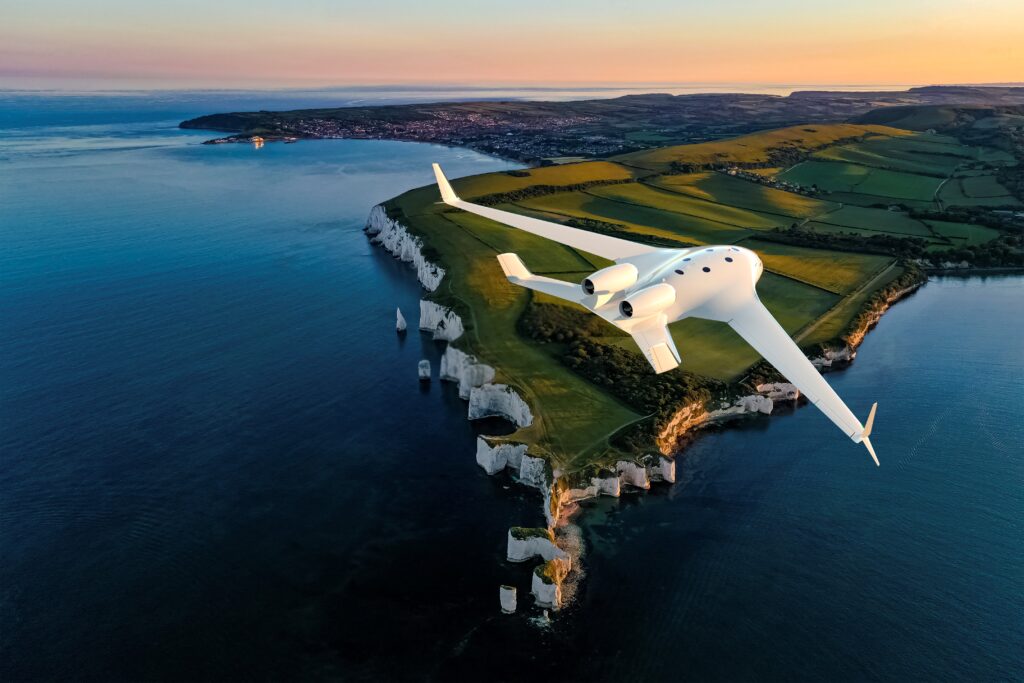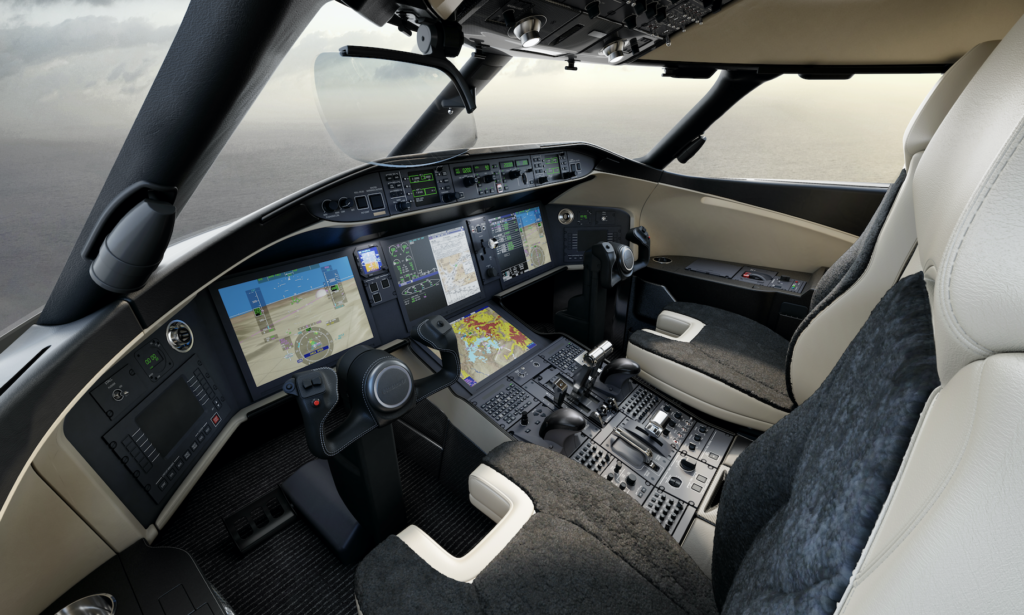Bombardier’s EcoJet Program: Advanced Aerodynamics and Digital Simulation


Bombardier is embarking on the second phase of testing for its EcoJet program, the company announced at the recent European Business Aviation Convention and Exhibition (EBACE). (Photos: Bombardier)
Bombardier is aligning its engineering expertise with its environmental commitments in its innovative EcoJet program. In an interview with Avionics International, Benoit Breault, Bombardier’s Director of Research and Technology, shared insights into the company’s bold plans to align its Environmental, Social, and Governance (ESG) strategy with the wider industry goal of net-zero emissions by 2050. The company is leveraging its expertise in aerodynamics technology to reimagine the shape and systems of future aircraft for a more sustainable future.
The EcoJet program is a testament to Bombardier’s commitment to environmental responsibility. Born from a forward-thinking group of Bombardier engineers a decade ago, the initiative is about exploring the long-term future of aircraft design for business aviation, Breault explained. The team concluded that blended-wing technology could substantially reduce the aircraft’s drag, cutting down friction against the air, and in turn, decreasing fuel consumption. This substantial reduction in fuel consumption would lead to an equivalent decrease in emissions, a significant stride towards achieving the net-zero emissions goal.
“Just with aerodynamics, we can reach 15% to 20% of fuel burn reduction and, therefore, emissions reduction,” Breault said.
Testing and validation have been crucial in the initial stages of Bombardier’s EcoJet program. The company opted for scaled flight testing, a common practice in the industry, especially when dealing with unconventional airplane configurations. This method, Breault explained, minimizes risks associated with high-stakes testing and potential failures. The first phase involved experimenting with smaller vehicles, about 7% the scale of a Global 6500 airplane, resulting in a model with a wingspan of approximately six to seven feet. This phase provided crucial insights into the flight dynamics and flight controls integration with new aerodynamic shapes.

“Our biggest discovery is that we’ve been able to mostly match our simulations from our flight controls engineers,” he said. Engineers at Bombardier used sophisticated computer programs to create digital representations of their designs, thereby simulating the flight controls and airplane behavior in advance. These digital simulations, while not quite “digital twins,” aided in the development of flight control laws for the plane’s onboard computers. The completion of these initial tests and their close alignment with the simulated models provided the green light to proceed with larger-scale testing.
Bombardier announced at the recent European Business Aviation Convention and Exhibition (EBACE) that they are embarking on the second phase of testing. This involves a larger, more advanced model with a wingspan of around 18 feet. To support this effort, Bombardier has partnered with Siemens as their Product Lifecycle Management (PLM) partner, harnessing the company’s suite of tools to handle multiple aspects of product development, including CAD and simulation.
Breault emphasized the importance of this digital-physical synergy, highlighting how the EcoJet program has not only paved the way for revolutionary aerodynamic advancements but also set a precedent for product development at Bombardier. This digital evolution, running parallel with physical progress, promises to shape the future of the company’s engineering, driving further breakthroughs and innovations.
A significant aspect of the EcoJet program is the evolution of aircraft control architecture. Breault traced this evolution back to the historical switch from cable-based flight controls to fly-by-wire systems. The transition began with the CSeries, now known as Airbus 220, and the Global 7500. These aircraft marked the inception of what Breault refers to as the “first generation” of control architecture.
Looking ahead, Bombardier plans to leverage its expertise from the EcoJet program to shape the “next generation” of flight control architecture. This involves a balance of technological advancements, such as aerodynamics, and integration of the PLM platform. As the team navigates through these complex terrains of innovation, they are laying the groundwork for a radically different and more advanced aircraft control system. The insights gleaned from the EcoJet program are poised to redefine the company’s systems and flight controls architecture, setting new standards in aviation technology.

The cockpit of the Global 6500 business jet
Collaboration is a cornerstone of Bombardier’s EcoJet program and its broader research initiatives. Breault highlighted the company’s diverse network of partnerships, spanning more than 20 university research institutions and numerous small and medium enterprises both domestically and internationally. This strong academic-industrial nexus has notably influenced Bombardier’s research landscape, with several major research projects eventually contributing to the EcoJet configuration.
“We’ve worked with nine or ten major Canadian universities that have aerospace programs,” Breault noted. “We work closely with the NRC (National Research Council) of Canada, and specifically their Aerospace Research Center,” as well as other international institutions.
Bombardier’s team conducts collaborative research at the company’s flight test center in Wichita, Kansas. The company also recently expanded its research capabilities by opening a London-based engineering office at its Biggin Hill Service Center. With this multi-site approach, encompassing Montreal, Toronto, Wichita, and London, Bombardier leverages a global research perspective to drive forward its objectives.
Bombardier’s EcoJet program embodies an ambitious strategy toward achieving substantial emission reduction targets, aiming at a 50% reduction, according to Breault. This reduction strategy includes leveraging improvements in aerodynamics for a 20% reduction; advancing propulsion technology for another 20%; and finally, precise simulation for the final 10%.
“With SAF [sustainable aviation fuel], we believe we can get another 40% of emissions,” he said, adding that the remaining gap to the 2050 Net Zero goal could then be bridged by market-based measures such as credits.
EcoJet’s impact goes beyond the research labs and manufacturing floors. Breault speaks passionately of the program’s transformative impact on the company’s workforce and the wider public. The EcoJet program has not only stoked enormous internal engagement and positivity, making Bombardier a sought-after destination for both engineers and interns, but it has also piqued considerable public interest.
Breault underscores that the EcoJet is not merely a single project, but rather an umbrella of innovative and transformative technologies poised to evolve Bombardier’s entire portfolio. EcoJet’s influence will permeate short, medium, and long-term projects, refining and maturing various technologies to enhance the company’s aircraft offerings. Moreover, the research portfolio extends beyond the technical realm to potentially revolutionize operational procedures. Concepts such as increased pilot autonomy, single pilot operations, and eventually, optional pilot operations, signal a radical rethink of traditional operational methods.
“The EcoJet really is our research portfolio that will generate lots and lots of future opportunities,” Breault said.
—————
Boost Internet Speed–
Free Business Hosting–
Free Email Account–
Dropcatch–
Free Secure Email–
Secure Email–
Cheap VOIP Calls–
Free Hosting–
Boost Inflight Wifi–
Premium Domains–
Free Domains





